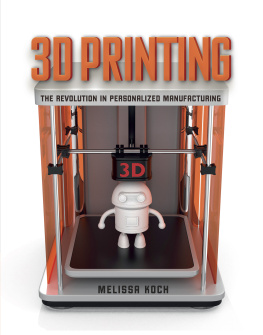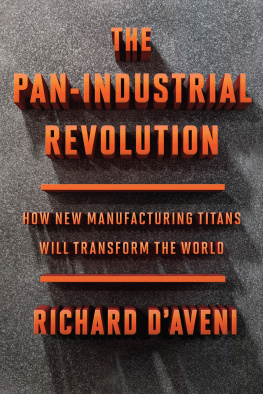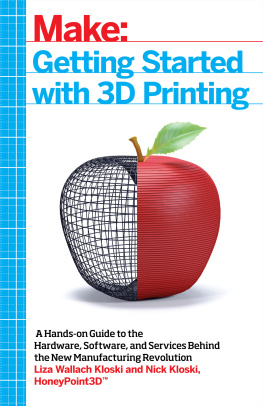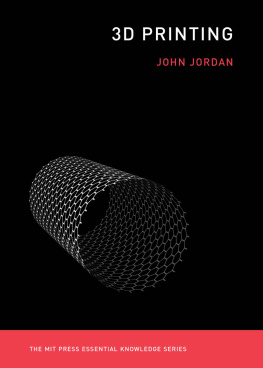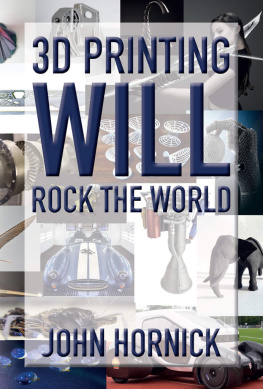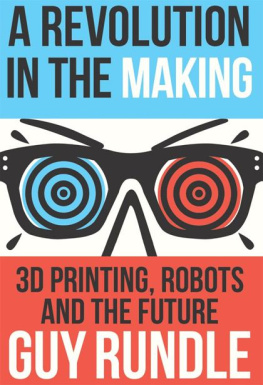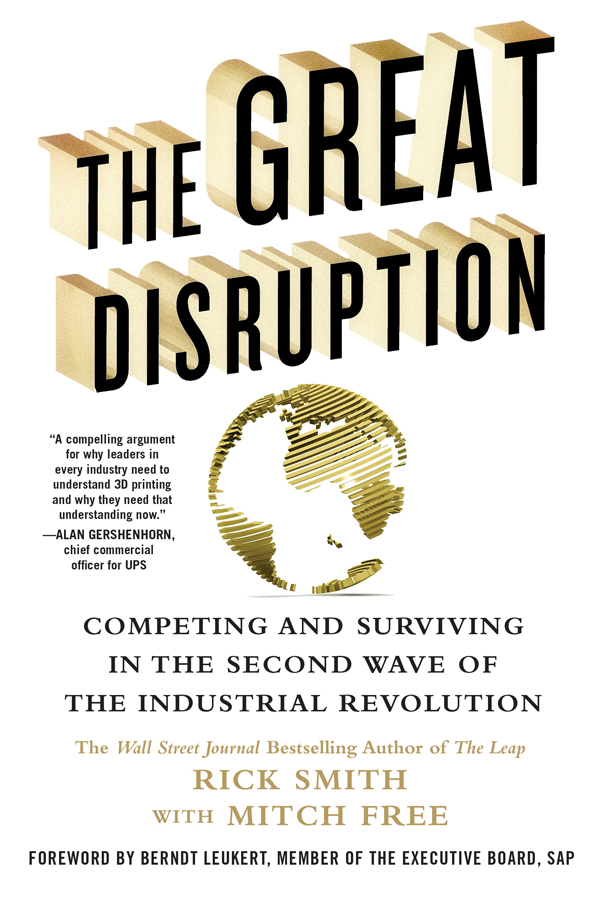Contents
Guide

The author and publisher have provided this e-book to you for your personal use only. You may not make this e-book publicly available in any way. Copyright infringement is against the law. If you believe the copy of this e-book you are reading infringes on the authors copyright, please notify the publisher at: us.macmillanusa.com/piracy.
To Lori Smith, mother of Arden, Adam, and Laine, and Shirene Free, mother of Mia
By Bernd Leukert,
Member of the Executive Board, SAP
IT MAY LOOK LIKE A relatively new invention, but the concept of 3D printing celebrated its thirty-fifth anniversary this year. In 1981, Hideo Kodama of Nagoya Municipal Industrial Research Institute published a paper describing a functional rapid prototyping system, printing physical objects in layers. Seven years later, fused deposition modeling (FDM) was inventeda technique that allows designers to create 3D models using digital data that can then be used to produce a tangible object.
While these technologies were by no means perfect, their potential was undeniable. But they also came with a hefty price tag. It wasnt until 2007 that the first 3D printer under $5,000 was introduced. As a consequence, the market went into consumer frenzy and a rapidly evolving industry fueled our dreams of having 3D printers in every household.
Nearly ten years later, this compelling consumer vision has still not been realized, remaining in the realm of the hobbyist. But, over the last five years, industrial 3D printing has significantly expanded and matured. The transition from prototypes and trinkets to fully on-demand manufacturing is here to stay, and is beginning to transform entire business models.
The reliability of industrial 3D printing today gives any manufacturing company, no matter the size or industry, the opportunity to consider 3D printing as an integral part of their production line capabilities. The technology is finally delivering on its original promise.
3D printings leap forward from printing shapes to manufacturing parts clearly marks a transformative moment in the history of manufacturing. 3D printing can now tackle industrial scale problems for companies both large and small, including automation, efficient production and new ways to manage inventories and extended supply chains.
According to a recently published report by the U.S. Department of Commerce,the total manufacturing and trade inventories in the United States are estimated at $1,807.1 trillion.
The supply chain implications of reducing the U.S. inventories levels even by 1 percent alone are astonishing$18 billion. The impact on the global economy, global supply chain, and even global climate are even greater.
But it does not stop there. 3D printing also allows companies to transform their business models and offer new digital services such as mass personalization, local manufacturing, same day delivery, to mention just a few examples.
That is why SAP is taking a leadership role, collaborating with prominent companies across manufacturing and extended supply chain to accelerate the transformation and digitization of manufacturing globally.
3D printing on a global scale has arrived. Brace yourself for the next Industrial RevolutionI wish you an inspiring read.
THE TIME IS EARLY 2015. The place: a large boardroom in the Minneapolis headquarters of 3M, a global manufacturing company with annual sales of $30 billion.
A few months earlier, Mitch Free and I had decided to start a new venture in 3D printing. Mitch has a deep manufacturing backgroundhe founded the global industrial marketplace MFG.com. I am what you could call a serial entrepreneur, having started businesses in several industries. We had both become fascinated with the emergence of industrial 3D printing. Our hunch was that the field already had some interest from Fortune 1000 companies. But neither of us knew for sure what we were venturing into until that day at 3M. To be honest, we were a bit anxious.
We introduced ourselves to Hector Dalton, 3Ms executive vice president in charge of manufacturing and supply chain, and other company executives. The meeting paused in an initial strained silence, so I tried to get down to business. Are there any specific areas where you believe that 3D printing will have a significant impact on 3Ms business?
Hector looked around the room, but no one said a word. Then Hector slowly leaned across the table toward us, arching his arms instinctively as if he were about to spring forward.
There isnt one area. This changes everything! We are about to witness a disruption of historic proportions.
A historic disruption?
At that moment I was struck with a flash of insight. We commonly think about the Industrial Revolution as if it were a binary switch. There was a before and an after. All of us live after the historic change, in a world safely and firmly set in the modern era. This IS the future!
But what if thats not right? What if the wrenching transformation of industry is not finished? What if everything was about to be flipped upside down all over again?
My mind was spinning, but my hand wrote down three words in a notebook, as if I was whispering them to myself.
The Great Disruption!
Fast-forward six months past that meeting. Mitch and I had interacted with dozens of companies from many different industries. They all had their own uses for 3D printing, but one thing had become clear. Our hunch about the size and scope of this historic disruption was now a firm belief. We, along with a growing number of leaders around the world, are convinced that 3D printing will change the way things are produced in this century more than the Industrial Revolution did over the past three hundred years. The Second Wave of the Industrial Revolution is coming, and the impacts are already beginning to wash up upon our feet. It may seem premature to make such claims. It is certainly bold. But it is not without cause.
Heres the quick explanation of how the technology works. Picture your current home or office document printer, but with two big differences. First, instead of printing with ink, a 3D printer uses plastics, ceramics, or even metal. Second, the printer doesnt do all its work in one pass and then move on to the next page. Instead a 3D printer continues going back and forth hundreds or even thousands of times. During each pass, it creates incredibly thin, precise layers on top of each other until you have a fully formed three-dimensional object.
Heres the amazing part: 3D printing, also known as additive manufacturing, didnt even exist until the late 1980s. Initially it was just making low-quality objects with plastic. Many people still associate the technology with novelty items. They are missing the disruption. Today, for example, General Electric is already 3D printing critical metal parts for jet engines. These components offer game-changing improvements in performance and weight, and cannot be made any other way. As the technology becomes cost competitive with traditional manufacturing, every other industryfrom shoes to cars to foods and medicine, and even housinghas the potential to similarly benefit. Which raises a key question: What are the limits of this disruption?
The truth is that we dont know exactly. We have seen that 3D printing is massively disruptive by itself. But as we will explore in the pages ahead, its full impact will likely result from a synthesis with other emerging technologies. The potential for combining 3D printed manufacturing with artificial intelligence, hyper-customization, computer-generated design, and the Internet of Things is mind-boggling. Also, dont expect 3D printings disruption to happen all at once. Many of the dramatic changes we discuss in this book will take years, in some cases even decades, to play out.


